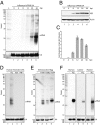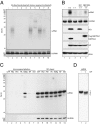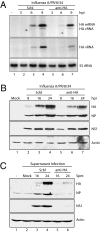Influenza A virus-generated small RNAs regulate the switch from transcription to replication
- PMID: 20534471
- PMCID: PMC2895093
- DOI: 10.1073/pnas.1001984107
Influenza A virus-generated small RNAs regulate the switch from transcription to replication
Abstract
The discovery of regulatory small RNAs continues to reshape paradigms in both molecular biology and virology. Here we describe examples of influenza A virus-derived small viral RNAs (svRNAs). svRNAs are 22-27 nt in length and correspond to the 5' end of each of the viral genomic RNA (vRNA) segments. Expression of svRNA correlates with the accumulation of vRNA and a bias in RNA-dependent RNA polymerase (RdRp) activity from transcription toward genome replication. Synthesis of svRNA requires the RdRp, nucleoprotein and the nuclear export protein NS2. In addition, svRNA is detectable during replication of various influenza A virus subtypes across multiple host species and associates physically with the RdRp. We demonstrate that depletion of svRNA has a minimal impact on mRNA and complementary vRNA (cRNA) but results in a dramatic loss of vRNA in a segment-specific manner. We propose that svRNA triggers the viral switch from transcription to replication through interactions with the viral polymerase machinery. Taken together, the discovery of svRNA redefines the mechanistic switch of influenza virus transcription/replication and provides a potential target for broad-range, anti-influenza virus-based therapeutics.
Conflict of interest statement
The authors declare no conflict of interest.
Figures





Comment in
-
A big role for small RNAs in influenza virus replication.Proc Natl Acad Sci U S A. 2010 Jun 22;107(25):11153-4. doi: 10.1073/pnas.1006673107. Epub 2010 Jun 14. Proc Natl Acad Sci U S A. 2010. PMID: 20547839 Free PMC article. No abstract available.
Similar articles
-
Influenza A virus NS2 protein acts on vRNA-resident polymerase to drive the transcription to replication switch.Nucleic Acids Res. 2025 Jan 24;53(3):gkaf027. doi: 10.1093/nar/gkaf027. Nucleic Acids Res. 2025. PMID: 39878213 Free PMC article.
-
Transcription and replication of the influenza a virus genome.Acta Virol. 2000 Oct;44(5):273-82. Acta Virol. 2000. PMID: 11252672 Review.
-
The RNA polymerase of influenza a virus: mechanisms of viral transcription and replication.Acta Virol. 2013;57(2):113-22. doi: 10.4149/av_2013_02_113. Acta Virol. 2013. PMID: 23600869 Review.
-
A Mechanism for Priming and Realignment during Influenza A Virus Replication.J Virol. 2018 Jan 17;92(3):e01773-17. doi: 10.1128/JVI.01773-17. Print 2018 Feb 1. J Virol. 2018. PMID: 29118119 Free PMC article.
-
Mutation of an Influenza Virus Polymerase 3' RNA Promoter Binding Site Inhibits Transcription Elongation.J Virol. 2020 Jun 16;94(13):e00498-20. doi: 10.1128/JVI.00498-20. Print 2020 Jun 16. J Virol. 2020. PMID: 32295915 Free PMC article.
Cited by
-
Adaptation of avian influenza A virus polymerase in mammals to overcome the host species barrier.J Virol. 2013 Jul;87(13):7200-9. doi: 10.1128/JVI.00980-13. Epub 2013 Apr 24. J Virol. 2013. PMID: 23616660 Free PMC article. Review.
-
A Review of the Interaction between miRNAs and Ebola Virus.Int J Mol Cell Med. 2024;13(2):210-219. doi: 10.22088/IJMCM.BUMS.13.2.210. Int J Mol Cell Med. 2024. PMID: 39184819 Free PMC article. Review.
-
Protein Coding and Long Noncoding RNA (lncRNA) Transcriptional Landscape in SARS-CoV-2 Infected Bronchial Epithelial Cells Highlight a Role for Interferon and Inflammatory Response.Genes (Basel). 2020 Jul 7;11(7):760. doi: 10.3390/genes11070760. Genes (Basel). 2020. PMID: 32646047 Free PMC article.
-
Diversity and Complexity of Internally Deleted Viral Genomes in Influenza A Virus Subpopulations with Enhanced Interferon-Inducing Phenotypes.Viruses. 2023 Oct 17;15(10):2107. doi: 10.3390/v15102107. Viruses. 2023. PMID: 37896883 Free PMC article.
-
Computational search of hybrid human/SARS-CoV-2 dsRNA reveals unique viral sequences that diverge from those of other coronavirus strains.Heliyon. 2021 Jun;7(6):e07284. doi: 10.1016/j.heliyon.2021.e07284. Epub 2021 Jun 17. Heliyon. 2021. PMID: 34179538 Free PMC article.
References
-
- Palese P, Shaw M. In: Fields Virology. 5th Ed. Knipe DM, Howley PM, editors. Philadelphia: Raven; 2007. pp. 1648–1698.
-
- Krug RM. Priming of influenza viral RNA transcription by capped heterologous RNAs. Curr Top Microbiol Immunol. 1981;93:125–149. - PubMed
-
- Tarendeau F, et al. Structure and nuclear import function of the C-terminal domain of influenza virus polymerase PB2 subunit. Nat Struct Mol Biol. 2007;14:229–233. - PubMed
-
- Guilligay D, et al. The structural basis for cap binding by influenza virus polymerase subunit PB2. Nat Struct Mol Biol. 2008;15:500–506. - PubMed
-
- He X, et al. Crystal structure of the polymerase PA(C)-PB1(N) complex from an avian influenza H5N1 virus. Nature. 2008;454:1123–1126. - PubMed
Publication types
MeSH terms
Substances
Grants and funding
LinkOut - more resources
Full Text Sources
Other Literature Sources
Research Materials

